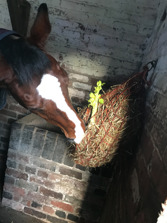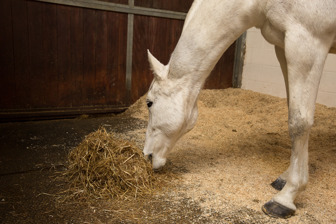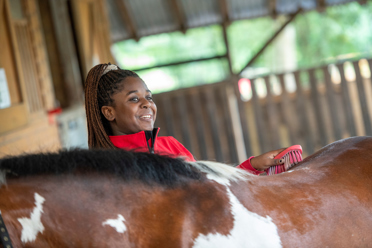Box rest is unfortunately something a lot of horse owners will have to deal with at some point. It can be a difficult time for the owner due to the extra work involved. However, being confined to the stable for a long period of time can also be a very stressful experience for the horse.
Horses on box rest may spend days or even weeks with little to do, no freedom of choice and no access to equine company for much of the day. It’s therefore important to consider how we can improve the box rest process and make it less stressful for our horses.
1. Can your horse have access to turnout?
Speak with your vet to see if your horse can be turned out for short periods, taken for walks to graze in hand or have access to a small paddock or outside yard.
2. Provide equine company
Horses need other equines for companionship and security, so make sure your horse always has a calm friend around, that they can ideally touch and interact with. As a minimum they must be able to see another horse. If the other horses on the yard are turned out for part of the day, can they take turns to stay in and provide companionship?
3. Provide plenty of forage
Plenty of good quality forage will keep your horse occupied and their digestive system working optimally. Ideally, give them a choice of different forages at different heights and positions in the stable – this will encourage them to change positions and provide interest and variety. Short-chopped forages or chaff will take longer to eat and fill their time, you could give them a choice every day in different bowls.


If you’re aiming to reduce the sugar and calorie content of your horses forage, soak some – or all – of their daily hay ration. To give your horse some variety you could soak some of their hay ration in herbal teas. Some horses love the taste of nettle, raspberry leaf, chamomile or mint, so soak some hay in a bucket and do a taste test to see which your horse prefers. Remember to make any changes to your horse’s diet gradually to reduce the risk of colic.
4. Maximise comfort and cleanliness
Horses need to be able to either lie flat out or in sternal recumbency (lying with their forelegs folded under them) to achieve a state of sleep with complete muscle relaxation, referred to as rapid eye movement (REM) sleep, so they must have plenty of room to do this to avoid sleep deprivation.
A big, deep bed will protect them when they get up and down. Rubber matting topped with a generous bed of shavings or straw with big banks around the walls will provide warmth, prevent knocks to their legs and may reduce the risk of them lying down too close to the wall and getting into a position where they can't get up, often referred to as cast.
Make sure their bed is kept clean by removing droppings regularly. Moving your horse to another stable or tying them up outside while mucking out will give them a change of environment and protect them from inhaling dust and ammonia when the bed is disturbed.
5. Spend quality time with your horse
Take this opportunity to spend some quiet time with your horse and get to know them better. Groom daily to maintain skin health, find out what their favourite grooming brush is and where their itchy spots are.
Scratching the wither area and around the base of the neck can lower your horse’s heart rate1 and help them relax, this is useful for stressful situations. You’ll know you have found the right spot when their nose starts twitching or they try to return the favour by scratching you back with their teeth!

6. Change their environment
If there’s space on the yard, then arrange for your horse to swap stables for part of the day to give them a change of scenery. Tie them up on different parts of the yard with a hay net to keep them occupied. Make sure they’re relaxed in their new environment, have equine company and are under your supervision when tied up.
7. Monitor your horse’s health
Check your horse over daily for any new bumps, scrapes and areas of heat, which could indicate a problem. Invest in a thermometer and take note of their temperature pulse and respiration rates.
Written and supported by Qualified Equine Behaviourist Justine Harrison CEBC ABTC-AAB
Get in touch – we’re here to help
The BHS Horse Care and Welfare Team are here to help and can offer you further advice with any questions you may have. Contact us on 02476 840517* or email welfare@bhs.org.uk – You can also get in touch with us via our social media channels.
Opening times are 8:35am - 5pm from Monday – Thursday and 8:35am - 3pm on Friday.
*Calls may be recorded for monitoring purposes.
References
- McBride, S.D et al (2004) A preliminary study on the effect of massage to reduce stress in the horse. Journal of Equine Veterinary Science. Volume 24, Issue 2, Pages 76-81.
